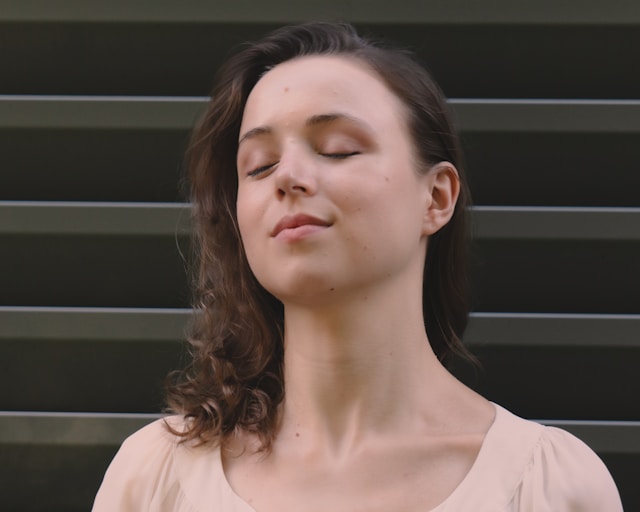If you’re like most people who experience anxiety, you probably want to learn how to get rid of it… and fast. It’s natural to seek quick relief from the uncomfortable feelings of dread, unease, and fear. However, mindfulness anxiety therapy in Willowbrook takes a different approach: rather than fighting anxiety, we work to change your relationship with it.
This might sound counterintuitive at first. Who wants to embrace their anxiety? But this shift in perspective is at the heart of effective awareness techniques for anxiety used in our Park Ridge and Willowbrook therapy offices.
Struggling with the need to control everything?
Our therapists in Willowbrook and Park Ridge specialize in helping clients find relief from control-driven anxiety using proven, evidence-based approaches.
The quicksand metaphor: Why fighting anxiety makes it worse
Imagine you’re stuck in quicksand. Your natural reaction would be to flail your arms and legs, desperately trying to escape. But this frantic movement actually causes you to sink faster. The counterintuitive solution? Stop fighting. Allow the quicksand to support you, and you’ll discover yourself floating on its surface.
Anxiety works the same way. The more you resist and fight it, the more entrenched you become. While there’s no magic solution for eliminating anxiety completely, there are specific strategies that work far better than trying to force it away.
At Life Counseling Institute, we help clients learn evidence-based techniques that have been proven effective for managing anxiety and panic attacks. Research has consistently shown that mindfulness-based approaches like the AWARE method are effective for reducing anxiety and depression. One large study published in the Journal of Consulting and Clinical Psychology reviewed the results from nearly 40 different clinical trials and found that mindfulness techniques helped people across a wide range of conditions, with especially strong results for those diagnosed with anxiety and mood disorders.
And this isn’t just something we’ve read about in the journals; we see tools like the AWARE method help clients all of the time.
The AWARE method: A mindfulness approach to anxiety
So what is the AWARE method? It’s one of the techniques I’ve found most helpful in my practice. The AWARE steps were developed by Dr. David Carbonell, a clinical psychologist who specializes in anxiety disorders and is known for his practical, accessible approach to treating panic and anxiety. Dr. Carbonell has been helping people manage anxiety for over 30 years and created the AWARE method specifically to give people a structured way to handle anxiety and panic attacks in the moment.
These awareness techniques for anxiety can be used with both general worry and acute panic attacks.
The AWARE method stands for:
- Accept
- Watch
- Act
- Repeat
- End
Let’s break down each step and explore how this mindfulness-based approach can help you manage anxiety more effectively.
Accept: Stop fighting what you feel
It’s natural to resist something that doesn’t feel good. When you start having scary “what-if” thoughts or notice tightening in your chest or a sinking feeling in your stomach, your instinct is to make these sensations disappear immediately.
But here’s the key principle in mindfulness anxiety therapy: Do the opposite of what you’d normally do.
Acceptance doesn’t mean you have to enthusiastically welcome anxiety or pretend it feels good. Rather, it means acknowledging that anxiety is acceptable and tolerable even though it’s obviously not desirable.
How do we know anxiety is acceptable and tolerable? Because it’s your body being in a state of discomfort. You feel scared, but that’s all it is. Anxiety attempts to trick you into thinking you are not okay.
My favorite phrase to remember when noticing and accepting anxiety is:
“I’m not in danger. I’m just super uncomfortable right now.”
Watch: Observe without acting
When you’re in a hyperactivated state, you usually feel compelled to do something, anything, to relieve the discomfort. But the same rule applies here: Do the opposite of what you’d normally do.
You actually don’t need to do anything to relieve anxiety or panic. Relief comes every single time, naturally, as anxiety moves in waves. Have you ever experienced an anxiety episode that never ended? It always subsides eventually.
- Instead of asking: “Why am I feeling this way and how do I make it stop?”
- Begin asking: “What do I notice?”
Practice these observation questions:
- How is my breathing right now?
- How do the muscles in my neck and shoulders feel?
- What’s going on around me in this moment?
- What does my “what-if” thinking sound like?
- Is this something I’m worrying about in my head, or does the problem actually exist in the world around me right now?
The more you can observe your anxiety, the less you will feel intertwined in it without a way out. This observational stance is a core component of both Cognitive Behavioral Therapy (CBT) and Acceptance and Commitment Therapy (ACT), which we use extensively in our anxiety treatment programs. Mindy Rothman, Licensed Clinical Professional Counselor (LCPC) and Associate Licensed Marriage and Family Therapist (ALMFT), who specializes in anxiety treatment using mindfulness-based approaches, explains the power of this observational shift:
“Mindfulness is not about clearing your mind; it’s about shifting from the judgmental narrative to a position of curiosity and self-observation. That simple awareness is the first and most powerful step toward anxiety relief.”
With her training in person-centered therapy and her own lived experience as a recovered social phobic, Mindy helps clients understand that the goal isn’t to achieve a perfectly calm mind, but rather to develop a different relationship with anxious thoughts and sensations.
Act: Make yourself comfortable (but don’t try to end the anxiety)
Here’s an important truth: It is not your responsibility to make your anxiety come to an end. Remember, anxiety comes in waves and gradually subsides each and every time.
You may be thinking, “But what if my anxiety never ends?” That’s anxiety talking! You don’t have to take your thoughts so seriously.
The goal in this step is to make yourself as comfortable as possible while the anxiety wave passes.
Belly breathing: A simple but powerful tool
One easy technique you can practice is belly breathing, also called diaphragmatic breathing. In belly breathing, you inhale and exhale with your stomach muscles rather than your chest muscles. Focus on really taking the time to fully exhale.
Proper breathing technique can activate your parasympathetic nervous system, which helps calm your body’s stress response. A comprehensive 2023 study published in Scientific Reports, a Nature journal, reviewed dozens of clinical trials examining the effects of breathing techniques on mental health. The researchers found that breathwork practices were consistently effective at reducing stress, anxiety, and depression across diverse populations. Notably, the benefits appeared quickly and were maintained over time, suggesting that deliberate breathing practices can provide meaningful relief for people experiencing these challenges.
The five senses grounding exercise
When anxiety takes over, your mind can get caught up in worry about the future or rumination about the past. It’s vital to get out of your mind and into your surroundings. One simple but powerful way to do this is the five senses grounding exercise:
Try this grounding exercise:
- Five things you see – Look around and name five things you can see right now
- Four things you feel – Notice four physical sensations (the texture of your clothing, the temperature of the air, your feet on the ground)
- Three things you hear – Listen for three sounds, whether nearby or in the distance
- Two things you smell – Identify two scents in your environment
- One thing you can taste – Notice one taste, even if it’s just the inside of your mouth
This sensory awareness exercise helps interrupt the anxiety loop by bringing your attention back to the present moment. By engaging all five senses, you’re essentially “grounding” yourself in reality rather than getting lost in anxious thoughts.
Respond to anxiety thoughts differently
Pay attention to how you’re responding to your anxiety and your “what-if” thoughts. Here’s an example of the difference between helpful and unhelpful responses:
- Anxiety voice: “What if I swerve off the road and crash right now while I’m driving?”
- Unhelpful, resisting response: “Shut up! That would never happen. But just in case, let’s stop on the side of the road for a while.”
- Helpful, accepting response: “Ah, a ‘what-if’ thought! This must be anxiety. I’m noticing a lot of discomfort, but I need to remember that it’s just a thought and I’m not in danger right now. I’m going to do the opposite of what my anxiety says and keep driving.”
This shift in how you respond to anxious thoughts is a cornerstone of effective anxiety treatment.
Repeat: Ride the waves
You may find another wave of anxiety comes up, and that’s completely okay. As long as you’re not attempting to resist and go into battle with it, you’re doing nothing wrong.
Sometimes, even when you use your helpful coping tactics, anxiety may pop up again. When this happens, simply start from the top and keep working through the AWARE steps.
Anxiety often comes in waves. Think of it like ocean waves … they rise, crest, and then naturally subside. Your job isn’t to stop the waves, but to learn how to ride them without being pulled under.
End: Trust that anxiety will pass
Your anxiety will end. It always does.
The more you resist, anxiety persists. When you can accept, anxiety will be less likely to take over your day.
Anxiety is a feeling of being afraid with no outward threats present. While being afraid isn’t pleasant, it’s a normal human emotion that is tolerable. You are capable of handling your anxiety.
The more you try to stifle it, push it down, suppress it, argue with it, or ignore it, the more it will come up stronger and louder.
So… get curious. Allow it in. Perhaps you’ll find it’s not so bad after all.
How therapy can help you practice the AWARE method
While the AWARE steps can be practiced on your own, working with a therapist who specializes in mindfulness anxiety therapy provides several advantages:
- Guided practice: Your therapist can walk you through the AWARE steps in real-time, helping you identify when you’re slipping into old patterns of resistance.
- Personalized application: Everyone’s anxiety is different. A therapist helps tailor these awareness techniques to your specific anxiety triggers and symptoms.
- Accountability and support: Having regular sessions provides structure and support as you build new habits for managing anxiety.
- Integration with other evidence-based approaches: The AWARE method works beautifully alongside CBT, ACT, and Exposure and Response Prevention (ERP) therapy.
At Life Counseling Institute in Willowbrook and Park Ridge, our therapists are trained in mindfulness-based approaches to anxiety treatment. We offer both in-person therapy and secure teletherapy throughout Illinois.
When to seek professional help for anxiety
While self-help strategies like the AWARE method can be incredibly valuable, sometimes anxiety requires professional support. Consider reaching out to a therapist if:
- Your anxiety significantly interferes with daily activities, work, or relationships
- You experience frequent panic attacks
- You avoid important activities or places due to anxiety
- You’ve tried self-help strategies but haven’t seen improvement
- You’re using unhealthy coping mechanisms (substance use, excessive avoidance)
- Your anxiety is accompanied by depression or other mental health concerns
You don’t have to face this alone. Effective, evidence-based treatment is available, and most people see significant improvement with the right therapeutic approach.
Frequently Asked Questions About Managing Anxiety
Q: How do I know if mindfulness-based approaches will work for my anxiety?
A: Mindfulness-based approaches, including the AWARE method, have strong research support for treating various anxiety disorders including generalized anxiety disorder, panic disorder, and social anxiety. These techniques work by changing your relationship with anxiety rather than trying to eliminate it completely. Most people find that with practice, mindfulness strategies significantly reduce the frequency and intensity of anxiety episodes. However, the best approach is often a combination of mindfulness techniques with other evidence-based treatments like Cognitive Behavioral Therapy (CBT). A therapist can help you determine the most effective treatment plan for your specific situation.
Q: What’s the difference between acceptance and giving up or resigning myself to living with anxiety forever?
A: This is an important distinction. Acceptance in the context of anxiety treatment doesn’t mean resignation or giving up on feeling better. Rather, it means accepting that anxiety is a normal human emotion that you can learn to tolerate and manage effectively. When you stop fighting anxiety and instead learn to observe it with curiosity, you actually reduce its power over you. Paradoxically, accepting anxiety often leads to experiencing less of it. The goal isn’t to be okay with suffering indefinitely; it’s to stop the exhausting battle that actually makes anxiety worse, so you can focus your energy on living the life you want.
Q: How long does it take to see results from practicing the AWARE method?
A: Many people notice some benefit from using the AWARE steps right away, particularly in managing acute anxiety or panic attacks. However, truly changing your relationship with anxiety is a gradual process that typically takes consistent practice over several weeks to months. The timeline varies depending on the severity of your anxiety, how long you’ve been experiencing it, and how regularly you practice the techniques. Working with a therapist can accelerate progress, as they can provide guidance, help you troubleshoot difficulties, and ensure you’re using the techniques correctly. Most clients in our Willowbrook and Park Ridge offices report noticeable improvement within 8-12 weeks of consistent practice combined with therapy.
Q: Can the AWARE method help with panic attacks, or is it just for general worry?
A: The AWARE method is highly effective for both general anxiety and acute panic attacks. In fact, it was specifically designed to help people manage panic attacks by providing a structured approach when you’re in a highly activated state. During a panic attack, the “Accept” and “Watch” steps are particularly crucial; they help you remember that what you’re experiencing is uncomfortable but not dangerous, and that the panic will pass without you needing to do anything to stop it. Many of our clients find that once they’ve practiced AWARE during general anxiety, they’re better equipped to use it during panic attacks. The key is practicing these steps when you’re relatively calm so the skills become more automatic during high-anxiety moments.
Q: What if I try the AWARE method but my mind races too much to focus on observing or accepting my anxiety?
A: A racing mind is one of the most common challenges when first learning mindfulness-based anxiety techniques. Remember, the goal isn’t to completely stop your thoughts or achieve a perfectly calm state. When you notice your mind racing, remember that awareness itself is the practice: simply noticing “my mind is racing” is an act of observation. You might find it helpful to start with very brief periods of practice (even just 30 seconds) and gradually increase the duration. Some people find it easier to focus on physical sensations (like their breath or the feeling of their feet on the ground) rather than trying to observe their thoughts directly. If you continue to have difficulty, a therapist can provide personalized guidance and help you identify what’s getting in the way. Sometimes, racing thoughts indicate that other therapeutic work needs to happen first before mindfulness techniques become accessible.
Ready to Get Counseling for Anxiety?
If you’re ready to change your relationship with anxiety and learn effective mindfulness-based techniques, our team at Life Counseling Institute in Willowbrook and Park Ridge is here to help. We offer both in-person and telehealth counseling throughout Illinois.
You Might Also Find It Helpful To Read:
- Relax, Nothing is Under Control: Learning to Live with Uncertainty
- Does Talking About Your Anxiety Help, or Hurt?
- 10 Daily Habits That Can Reduce Your Anxiety
Citations:
- Hofmann, S. G., Sawyer, A. T., Witt, A. A., & Oh, D. (2010). The effect of mindfulness-based therapy on anxiety and depression: A meta-analytic review. Journal of Consulting and Clinical Psychology, 78(2), 169–183.
- Fincham, G. W., Strauss, C., Montero-Marin, J., & Cavanagh, K. (2023). Effect of breathwork on stress and mental health: A meta-analysis of randomised-controlled trials. Scientific Reports, 13, 432. https://doi.org/10.1038/s41598-022-27247-y







